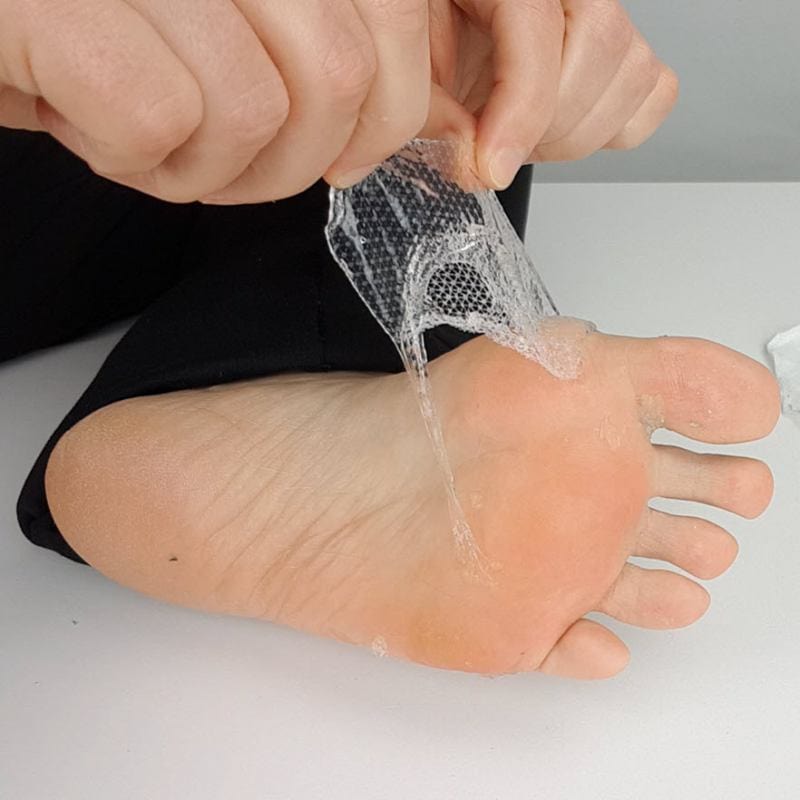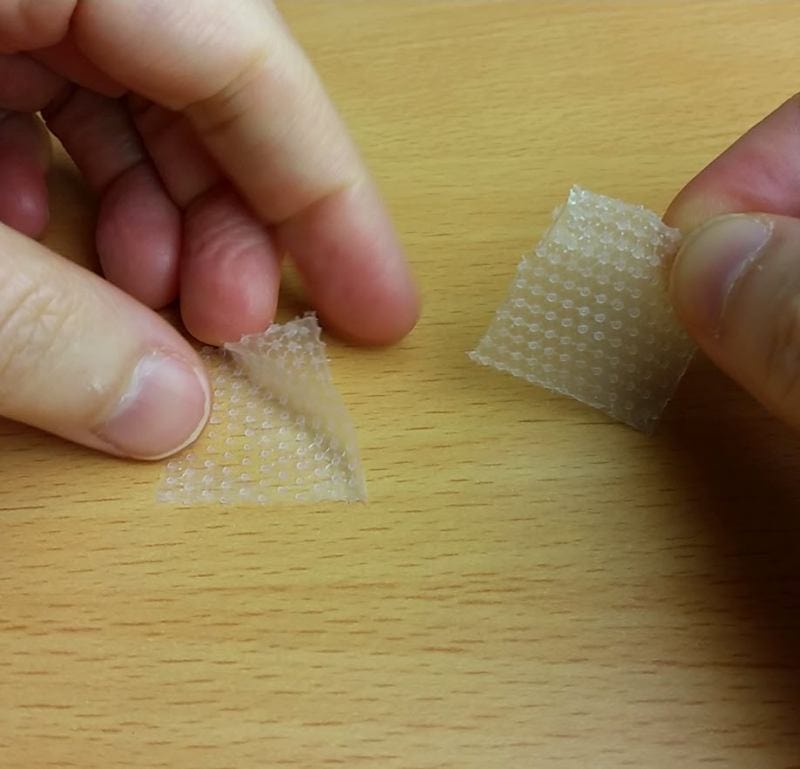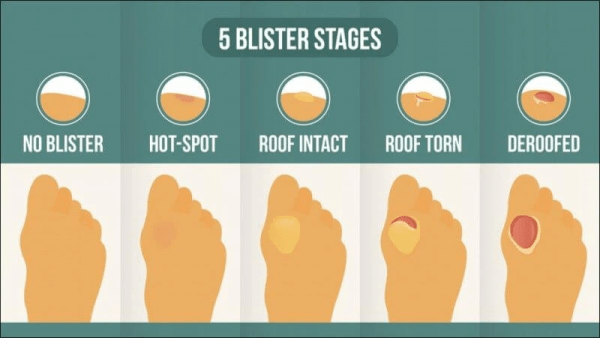- Spenco 2nd skin Circles and Rectangles that also come in a tubs
- The Moist Pads that come in the Spenco 2nd Skin Blister Kit and Dressing Kit
- And Spenco 2nd Skin Moist Burn Pads
Collectively, Spenco refer to these products as their HYDROGELS. Same material, just different shapes, sizes and packaging. They all have the same look and feel, same ingredients and same properties. To be honest, I’ve never had a lot of time for this product. But at the same time, I can’t help but be impressed by it. If you haven’t held Spenco 2nd Skin Squares or any of the hydrogels in your hand before, they have a really distinctive texture – it’s a gooey sticky jelly material that’s soft and really cool to the touch. It’s actually 95% water.
How Spenco 2nd Skin Squares Work
I can see that this product has the ability to reduce pressure by way of its cushioning. And even more impressive than that, it absorbs shear beautifully. Just look at it go! Both cushioning and shear absorption are fantastic properties for blister prevention. So what DON’T I like about Spenco 2nd Skin hydrogels when it comes to blister management? There are 5 things that bother me:
1) 95% Water
Firstly, holding water against the skin is the opposite of what you want to do in blister prevention. More moisture means higher friction levels which can mean either more blisters, or worst still, maceration.
2) Cooling?
Secondly, cooling the skin might be good for treating burns, but it is of limited use for preventing or treating friction blisters. Remember, friction blisters on the feet are not a burn injury. We know you can still get blisters in very cold conditions. It’s not about temperature, it’s about the repetitive shear distortions within the skin. Besides, it might feel nice and cool initially, but it soon warms up to the same temperature as your foot. You don’t just lay Spenco 2nd Skin Squares on your skin and leave it there. You have to put tape over it so it stays in place. So it’s bound to your skin and insulated by the tape. This ensures any cooling effect is very short-lived.
3) Wear
Thirdly, the jelly wears through if there’s a lot of pressure and movement applied to it. That’s not so good when you’re dealing with blisters on weightbearing areas of your foot, like under the ball of the foot. I put it under my 1st MPJ and jogged on the spot and there was no gel left where I needed it most, when I checked after 10 minutes. The gel had worn through. When you look closely at the product, it’s not that difficult to replicate this. You can move that gel away with moderate effort to reveal the plastic mesh underneath. Watch the video at the top of this article shows this in detail. On my other foot, I used a large rectangle pad right across the ball of my other foot and I started to do some star jumps. This was awkward to say the least, because the give in the gel was too much. The shear modulus is too low for this part of the foot for this kind of activity. Why? Because your foot relies on traction to perform star jumps, just like it does for walking and running and changing direction with any efficiency. The problem is, this hydrogel works TOO well. It absorbs so much shear that it degrades your efficiencies of gait, including breaking and acceleration forces. So, I couldn’t continue with the star jumps or I would have sprained my ankle or tweaked my inner thigh muscles. So I just jogged on the spot for 10 minutes and when I took my shoe and sock off, at least half the gel had escaped the confines of the surrounding tape that was designed to hold the hydrogel in place. And of course, that rendered the hydrogel useless because it was no longer where I needed it.
 p>
p>
Spenco 2nd Skin Rectangle from Dressing Kit - After 10 minutes, the hydrogel had worn through and moved away from the weightbearing areas. Watch the video for more details.
4) Dries Out
Fourthly, the Spenco 2nd Skin Squares dry out and as they do, they lose their favourable properties from the gooey jelly thickness. When they dry right out, they just look and feel like a rough thin plastic sheet. At this point, they are more of an irritant than anything else. To minimise this and to make the favourable properties last longer, make sure you leave the clear plastic film on the hydrogel. You remove only the blue backing, put it on your skin and then tape over it. That clear plastic film between the gel and the tape means there’s less water absorption by the tape and less evaporation of water through the tape.
 p>
p>
Spenco 2nd Skin Squares dried out - watch the video for more
5) Not Sterile
Finally, they’re not sterile and it’s impossible to handle them in a sterile way. So that automatically means they’re no good for torn or deroofed blisters. You can only use them on blisters with an intact roof. Or, as a blister prevention strategy. Personally, I wouldn’t even use this on a blister with an intact roof. I’d be afraid I’d be macerating already weakened skin due to the high-water content. I would only use this product to prevent blisters, either at the hotspot stage, or before it even got to a hotspot – just on my known blister susceptible areas, as long as they’re not on weightbearing areas of my feet where I need traction.
 p>
p>
The 5 stages of blister development.ersonally, I would only use Spenco 2nd Skin Hydrogels at the first two stages (ie: blister prevention)
Spenco 2nd Skin Squares Absorb Shear Brilliantly! But...
I love how the material undergoes shear. This is blister prevention gold. This is what I absolutely love. It’s such a great way to prevent blisters. It takes up all that back and forth movement that usually would be imparted to the skin and cause a blister. However, on weightbearing areas, it works too well initially, and then the hydrogel wears through too quickly to become ineffective.
Which Blisters To Use Spenco Hydrogel Products On
Unfortunately, this very short-term effect takes them out of the equation for anyone involved in endurance activities. Anyone looking for blister management that lasts all day. However, for anyone wanting to give them a go, I would say they are suited most to blisters on non-weightbearing areas of the foot and areas of low pressure, like between the toes, under the arch and at the back of the heel. But I'd always be mindful of the potential for maceration. I wouldn't even try them under the forefoot, under the heel, or on any edge blisters. The need for traction and the significant pressure component make them unlikely to help for any length of time.
Wrapping Up
I hope this helps in your quest to be blister-free, no matter what sport, activity or adventure you have planned. Take into account the pros and cons mentioned, but you do your own research and experimentation. For long-lasting shear absorption in an effort to prevent toe blisters, I'd highly recommend gel toe sleeves (below). They're fantastic!








